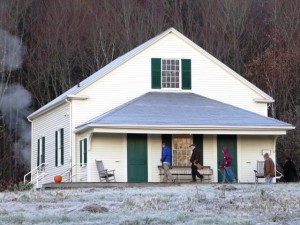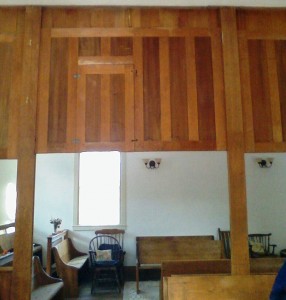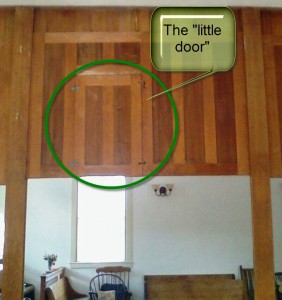Michael Rice
The meeting house at Woolman Hill in Deerfield, Massachusetts, is an ancient historical structure brought to this Quaker Conference Center from its original location in North Dartmouth, where it had served as the Quaker Meeting House for two centuries but had lost its congregants some decades ago. In order to preserve this historical treasure and restore it to use as a place for worship, its trustees gifted the old Meeting House to the conference center, and the pertinent institutions had it jacked up, loaded on a flat-bed trailer, and moved from the Southeastern extremity of Massachusetts to the hill overlooking Deerfield in the west-central part of the state over100 miles away.
is an ancient historical structure brought to this Quaker Conference Center from its original location in North Dartmouth, where it had served as the Quaker Meeting House for two centuries but had lost its congregants some decades ago. In order to preserve this historical treasure and restore it to use as a place for worship, its trustees gifted the old Meeting House to the conference center, and the pertinent institutions had it jacked up, loaded on a flat-bed trailer, and moved from the Southeastern extremity of Massachusetts to the hill overlooking Deerfield in the west-central part of the state over100 miles away.
I have visited Woolman Hill at least annually for some years and have invariably meditated within this beautiful structure. I was vaguely aware that, originally, women and men used separate entrances, and sat on separate sides, but I’ve forgotten which side served whom. I had even noticed the once movable panels, sliding up and down in vertical slots, presumably to obscure the distracting visages of congregants of the opposite sex. On a recent visit, I took note of a segment of rope at the top of each off the four panels, which I take to have been connected to a mechanism for lowering them, though I doubt that this mechanism is currently functional. More: one of the panels has, at its bottom, a hinged door about 18 inches wide and 26 inches tall. What was the function of that door?
At first I thought that, perhaps, children no taller than two feet could be allowed to shuttle between Father and Mother when the strain of Quaker silence became unbearable. Then, unaccountably, I imagined family dogs might use that passage, though upon reflection, I suspect that pets were not welcome at Quaker Meetings for Worship. Nevertheless, I delighted in thinking of this mysterious opening as the “dog and kiddie” door. But then it became both a metaphor and the germ of a game, “name that door.”
I like to think of myself as a social change activist, seeking a more just and peaceful world with due respect for and connection with the earth, the water, the air — indeed, all the living components of the natural world. I want, in Gandhi’s words, “to become the change I wish to see in the world.” The difficulty in this enterprise is that I stay in my comfort zone: I self-select or self-segregate by sitting with those who share my visi on of change. I “speak to the choir.” I get few opportunities to speak with those who have an opposing vision: they shun my presence as I shun theirs; they do not hear my sermons any more than I attend theirs. And it is THAT which that door symbolizes: the space that the comprises the common interest of people sitting in isolation from one another, like the toddlers shared by the Father and the Mother traditionally seated on the two sides of a partition.
on of change. I “speak to the choir.” I get few opportunities to speak with those who have an opposing vision: they shun my presence as I shun theirs; they do not hear my sermons any more than I attend theirs. And it is THAT which that door symbolizes: the space that the comprises the common interest of people sitting in isolation from one another, like the toddlers shared by the Father and the Mother traditionally seated on the two sides of a partition.
The challenge of “Name that Door” is to identify the myriad commonalities between the factions.
